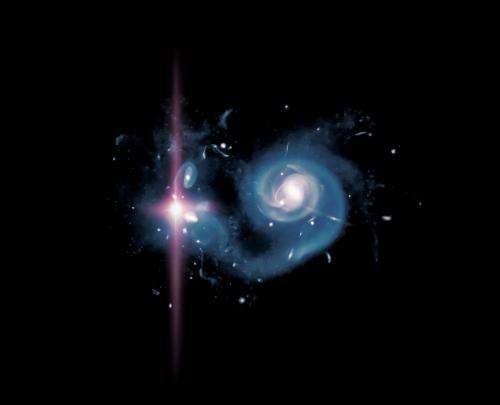Distant super-luminous supernovae found

(Phys.org)—Two 'super-luminous' supernovae - stellar explosions 10 to 100 times brighter than other supernova types - have been detected in the distant Universe.
The discovery, led by Swinburne University of Technology astrophysicist Dr Jeffrey Cooke, and reported online in Nature this week, sets a record for the most distant supernova yet detected.
"The light of these supernovae contains detailed information about the infancy of the Universe, at a time when some of the first stars are still condensing out of the hydrogen and helium formed by the Big Bang," Dr Cooke said.
Super-luminous supernovae were first discovered only a few years ago and are extremely rare in the nearby Universe.
The origins of super-luminous supernovae are not well understood, but a small subset of them are thought to occur when extremely massive stars, 150 to 250 times more massive than our Sun, undergo a nuclear explosion triggered by the conversion of photons into electron-positron pairs. This process is completely different compared to all other types of supernovae.
Such events are expected to have occurred more frequently in the early Universe, when massive stars were more common.
The expected frequency and the extreme brightness of these events encouraged Dr Cooke and his colleagues to search for super-luminous supernovae at redshifts greater than 2, which corresponds to more than 10 billion years ago when the Universe was less than one-quarter of its present age.
"Our program uses a novel image-stacking technique and monitors tens of thousands of infant galaxies targeted because they are rapidly forming stars, which increased our chances of detecting the supernovae," Dr Cooke said.
Using the giant Keck telescope in Hawaii, the researchers searched through a large volume of the early Universe and found two super-luminous supernovae, at redshifts 2.05 and 3.90 - breaking the previous 'normal' supernova redshift record of 2.36. Swinburne's investment in Keck Observatory telescope time and supportive research vision made this work possible.
"Other than hydrogen and helium, all elements such as carbon, oxygen, iron, and silicon, were manufactured in the cores of stars or during supernova explosions and ejected by the supernovae into space to cool and form the next generation of stars," Dr Cooke said.
"The multitude of supernovae over cosmic time enriched the Universe with heavy elements that eventually produced the diverse set of galaxies, stars, and planets we see around us today."
The present results suggest that detection of the first generation of stars may not be far from our grasp.
"Finding the first generation of stars is the current Holy Grail for astronomers. The distances of our supernovae overlap with the distances where we expect to find the first stars.
"Our search technique provides the means to detect and study the deaths of the first generation of stars and understand the chemical enrichment process of the Universe from the beginning."
More information: The paper, entitled "Super-luminous Supernova Discoveries at z=2.05 and z=3.90," is published online in Nature at www.nature.com/nature/journal/ … ull/nature11521.html and will appear in the November 8 print edition.
Journal information: Nature
Provided by Swinburne University of Technology



















